Abstract
The purpose of this study was to determine the antioxidant activity of the seed shells and kernels of Jatropha curcas L. The extracts obtained from five solutions (0%–95% ethanol) were tested and compared. Overall, the antioxidant capacity of seed shell extracts was higher than that of seed kernel extracts. The seed shell extract obtained using 95% ethanol exhibited the best antioxidant activity among the five solutions. The half-maximal inhibitory concentration (IC50) of 1,1-diphenyl-2-picrylhydrazyl and free radical scavenging ability of 2,2’-azino-bis(3-ethylbenzothiazoline-6-sulphonic acid) were 13.63 ± 0.15 and 6.75 ± 0.51 μg/mL, respectively. The reduction ability and total phenol content were 95.14 ± 27.04 μg ascorbic acid equivalents/mg of extract and 536.33 ± 8.62 μg gallic acid equivalents/mg of extract, respectively. In in vitro cytotoxicity assays, solutions with less than 250 μg/mL of seed shell extract had no major cytotoxicity. The seed shell of Jatropha curcas L. can be used as an antioxidant material and has potential for biomedical applications.
1. Introduction
Plant-derived bioactive compounds have received considerable attention because of their therapeutic potential as anti-inflammatory, anticancer, and antioxidant substances [1]. Jatropha curcas L. is a tropical and subtropical plant that has multiple uses and considerable economic potential [2,3,4]. It belongs to the Euphorbiaceae family [5], whose aqueous and organic extracts have been traditionally used as laxatives, scavengers, emetics, and therapeutics [6]. Although J. curcas is toxic, some of its parts are suitable for therapeutic uses [7]. For example, its root and latex, which contain phenolic and flavonoid compounds, exhibit notable antioxidant, antihypertensive, antiplatelet, and anti-inflammatory activities [8]. The methanolic extract of leaves has anticrustacean and antiviral activities [9]. The stem and root barks have antibacterial properties and can be a source of antibacterial compounds [10]. The root contains curcusone A–E [11], which can be used for the treatment of many diseases [12]. Curcusone A and B, which are found in the stem, have anticancer activity. Moreover, curcusone B effectively suppresses metastatic processes [12]. The main source of toxicity in seeds is the kernel [13]. However, no information exists regarding the toxicity of the seed shell.
The seed extract of J. curcas exhibits significant antioxidant activity, and the hydroalcoholic extract of J. curcas exhibits potent activity for protecting against oxidant and free radical injuries [14]. The kernel of J. curcas has a high total phenolic content and exhibits strong antioxidant activity [15]. The extract of J. curcas seed shells has a high phenolic content and exhibits relatively strong bioactivity. J. curcas seed shells are a new natural antioxidant source and can be used in the industry [16]. The kernels of J. curcas contain nitrogen, phosphorous, and potassium and can be used as fertilizers [16,17].
To the best of our knowledge, the antioxidant capacity of J. curcas seed shells and kernels has rarely been studied. Water, methanol, and ethanol are suitable extraction solvents for polyphenolic compounds to optimize the antioxidant capacity of J. curcas seed shell and kernel extracts [18]. Studies have been conducted on different solvent extractions [16]; however, the differences in ethanol extraction at a series of concentration have been less studied. Therefore, this study investigated the in vitro antioxidant activity of the seed shell and kernel extracts of J. curcas by using five types of ethanol solutions with different polarities.
2. Materials and Methods
2.1. Reagents
2,2’-azino-bis(3-ethylbenzothiazoline-6-sulphonic acid) (ABTS) and 1,1-diphenyl-2-picrylhydrazyl (DPPH) were purchased from Alfa Aesar (Tewksbury, MA, USA). Ascorbic acid and trichloroacetic acid were obtained from Acros Organics (Fair Lawn, NJ, USA). Potassium persulfate and potassium ferricyanide were obtained from Showa Chemical (Tokyo, Japan). Phosphate buffer and sodium carbonate were purchased from Riedel-de Haën (Seelze, Germany). Folin–Ciocalteu phenol reagent and dimethyl sulfoxide (DMSO) were obtained from Sigma-Aldrich (St. Louis, MO, USA). Iron (III) chloride hexahydrate was purchased from J.T. Baker (Phillipsburg, NJ, USA), and Dulbecco’s modified Eagle’s medium (DMEM) was obtained from HyClone Lab (Logan, UT, USA). Dulbecco’s phosphate-buffered saline (PBS) was provided by Medicago (Uppsala, Sweden), and MTT was procured from Gold Bio (St Louis, MO, USA).
2.2. Preparation of Extracts
J. curcas seeds (Figure 1) were collected from the location with GPS coordinates (24.446718, 120.792095), Miaoli, Taiwan. The collection and further experiments were conducted from December 2018 to January 2019. The seeds were placed in an oven and dried at 50 °C. The shell and kernel were then manually separated, further dried, and powdered using a pulverizer. Seed shell and kernel extracts were prepared in three replications by dissolving seed shell and kernel powder in 0%, 25%, 50%, 75%, and 95% ethanol at a ratio of 1:10 g/mL at a constant temperature of 30 °C for 1 h as original sample solutions. The solvent was removed using a vacuum rotary evaporator. The dried extracts were examined for determination of extraction yield and extract concentration in original sample solutions. All antioxidant experiments used the original sample solutions, but cytotoxicity test used the redissolved extract solutions with 2.5% DMSO.

Figure 1.
Seed shell and kernel of Jatropha curcas L.
2.3. 1,1-diphenyl-2-picrylhydrazyl Radical Scavenging Assay
According to the procedure developed in previous studies [19,20,21,22,23], a total of 2 mL of the tested sample was mixed with 2 mL of 0.2 M DPPH solution and then left in the dark for 30 min. The absorbance of the resulting mixture was measured at 517 nm. A lower absorbance value resulted in a stronger ability of the sample to scavenge free radicals. Ascorbic acid was used as the standard, and a solution with a corresponding ethanol concentration was used as the control.
2.4. 2,2’-azino-bis(3-ethylbenzothiazoline-6-sulphonic acid) Radical Scavenging Assay
By the previous procedure [19,22], an ABTS solution was prepared by reacting equal proportions of 7 mM ABTS with 2.45 mM potassium persulfate at room temperature in the dark for 16 h. The background absorbance was diluted to 0.7 ± 0.02 by using 95% ethanol. A total of 1.5 mL of the tested sample was mixed with 1.5 mL of the diluted ABTS solution for 10 min in the dark. The absorbance of the resulting mixture was then measured at 734 nm. A lower absorbance value corresponded to a stronger ability to scavenge free radicals. Ascorbic acid was selected as the standard, and a corresponding ethanol solution was used as the control.
2.5. Reducing Power Assay
Based on the previous procedure [19,22], an aliquot of the sample (0.5 mL) was mixed with 1 mL of phosphate buffer (0.2 M, pH 6.6) and 0.5 mL of 1% potassium ferricyanide at 45 °C. After 30 min of reaction, the mixture was rapidly cooled. Subsequently, 0.8 mL of trichloroacetic acid (1%) and 1.5 mL of iron (III) chloride hexahydrate (1%) were added. The absorbance of the resulting mixture was measured at 700 nm. A higher absorbance value corresponded to a stronger reducing power of the sample. Ascorbic acid was used as the standard in the reducing power assay. The reducing power of the tested sample is expressed in μg of ascorbic acid equivalents (AAEs)/mg of extract.
2.6. Determination of the Total Phenolic Content
A total of 0.4 mL of each extract was mixed with 2 mL of 10% Folin–Ciocalteu phenol reagent [20,21,22,23,24]. After 5 min, 1.6 mL of 7.5% sodium carbonate was added to the mixture. The mixture was then incubated for 30 min. The absorbance of the resulting mixture was measured at 760 nm. Gallic acid, which is a major component of hydrolyzable tannis, was used as the standard when determining the total phenol content. The total phenolic content of the tested sample is expressed as micrograms of gallic acid equivalents (GAEs) per milligram of extract.
2.7. In Vitro Cytotoxicity Test
The cytotoxicity of the extract was evaluated using a mouse fibroblast L929 cell line. The cell line was obtained from the Bioresource Collection and Research Center (Hsinchu, Taiwan). The cells were cultured in Dulbecco’s MEM with 10% horse serum at 37 °C in a humidified incubator with 5% CO2. The seed shell extract samples were prepared by dissolving them in a 2.5% DMSO solution, adjusted to the final concentrations, and then sterilized with a sterile filter.
The cells were seeded in a 96-multiwell plate at a cell density of 1.0 × 104 cells/well in 100 µL of culture medium and maintained in a humidified incubator with 5% CO2 at 37 °C for 24 h. The culture medium was then removed, and the cultured cells were treated with serial dilutions of the extract (17–1000 µg/mL). After an incubation time of 24 h, the culture medium was removed and 100 µL of methylthiazol tetrazolium (MTT) solution (5 mg/mL in PBS) was added and incubated for 3 h. After incubation, the MTT solution was removed and 100 µL of DMSO was added to each well and left in the dark for 15 min. The absorbance was then measured at 570 nm to calculate the percentage of surviving cells.
2.8. Statistical Analysis
To ensure statistical representation, all of the experiments were collected at least in triplicate, and means between the treatment levels were compared by using the SAS software (version 9.4, SAS Institute, Cary, NC, USA). Statistical analyses based on the t-test and analysis of variance (ANOVA). If the treatment was significant (p < 0.05) in ANOVA, the treatment mean compared with the Tukey test.
3. Results and Discussion
3.1. Extraction Yield
The extraction yield of J. curcas seed shells and kernels is dependent on the extraction solution and seed material. Table 1 presents the extraction yields of the seed shells and kernel for different ethanol solutions. The extraction yield of the shell was lower than that of the kernel. The extraction yield of the shell ranged from 3.00 ± 0.45 to 14.81 ± 0.92, and the extraction yield of the kernel ranged from 8.19 ± 1.26 to 24.23 ± 0.78. Similar results have been obtained for other plant species, such as pecan [25] and hazelnut [26].

Table 1.
Extraction yield (%) of seed shells and kernels with different ethanol solutions.
Moreover, a higher extraction yield was achieved with a lower ethanol concentration as shown in Table 1, which is in agreement with the finding that the extraction efficiency is low and unfavorable in a mixture with no aqueous content [27]. However, in this study, no obvious difference was observed in the extraction yield among the solutions with 0%–25% ethanol in seed kernels and with 25%–50% in seed shells. Furthermore, the use of different solvents in the extraction resulted in different antioxidant activities among the extracts [28].
3.2. DPPH Radical Scavenging Assay
Oxidative stress due to the accumulation of free radicals may cause heart disease, cancer, diabetes, ischemia, and aging. The negative effect of free radicals on the body can be resisted by antioxidants [29]. Figure 2 displays the DPPH radical scavenging activity of seed shell and kernel extracts obtained from different extraction solutions in this study. The result indicates that the DPPH radical scavenging activity increased with the concentration of the extracts, irrespective of the extraction solution used. The seed shells extracted from concentrated ethanol solutions had high DPPH radical scavenging activity. The half-maximal inhibitory concentration (IC50) values in the DPPH radical scavenging assay of the shell were 721.84 ± 8.04, 101.66 ± 8.92, 40.82 ± 1.65, 28.09 ± 3.41, and 13.63 ± 0.15 μg/mL for solutions obtained using 0%, 25%, 50%, 75%, and 95% ethanol, respectively (Figure 2a). The corresponding IC50 values for the kernel were 1195.60 ± 87.56, 1409.19 ± 65.83, 1239.22 ± 44.79, 1698.33 ± 54.28, and 1729.31 ± 118.46 μg/mL, respectively (Figure 2b). The IC50 of ascorbic acid in a water solution was 8.35 ± 1.12 μg/mL. Therefore, the shell extract obtained using 95% ethanol had the best DPPH free radical scavenging activity, similar to that of ascorbic acid. This result is in agreement with a previous report [16]. However, the kernel extracts had poor DPPH free radical scavenging activity, considerably lower than that of ascorbic acid. According to the previous study [30], an extract of defatted J. curcas seeds also exhibited DPPH radical scavenging activity.
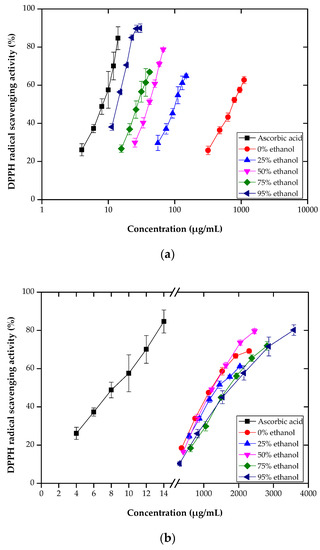
Figure 2.
DPPH radical scavenging activities of the seed (a) shell and (b) kernel extracts from different ethanol solutions.
3.3. ABTS Radical Scavenging Assay
Figure 3 displays the ABTS radical scavenging results for the seed shell and kernel extracts obtained from different ethanol solutions. Similar to the trend displayed in Figure 2, a trend of increasing ABTS radical scavenging activity with increasing extract concentration was observed, regardless of the type of extraction solution used. The seed shell extracts obtained from concentrated ethanol solutions had high ABTS radical scavenging activity. The shell extract obtained using 95% ethanol had the best IC50 value in the ABTS free radical scavenging assay. The result that an increase of ethanol concentration had in a higher ABTS radical scavenging activity agrees with the report about Salvia jurisicii [31] and Withania somnifera [32]. The IC50 values in the ABTS assay were 161.00 ± 5.40, 50.19 ± 2.96, 21.47 ± 0.91, 12.17 ± 0.67, and 6.75 ± 0.51 μg/mL for shell extracts obtained using 0%, 25%, 50%, 75%, and 95% ethanol solutions, respectively (Figure 3a). The corresponding IC50 values for the extracted kernels were 62.61 ± 2.71, 134.80 ± 9.04, 142.11 ± 16.83, 211.72 ± 23.64, and 329.71 ± 48.14 μg/mL, respectively (Figure 3b). Therefore, the shell extracts had in a higher ABTS radical scavenging activity than kernel extracts, corresponding to the report about Corylus jacquemontii [33]. The IC50 of ascorbic acid in water solution was 4.08 ± 0.25 μg/mL. The results of the ABTS and DPPH free radical scavenging assays indicated that the extracted J. curcas shells had strong free radical scavenging activity and could be used as effective free radical scavengers.
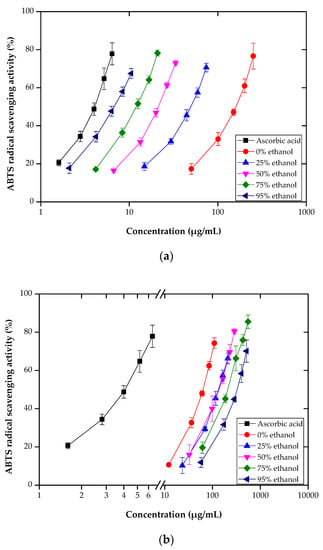
Figure 3.
ABTS radical scavenging activities of the seed (a) shell and (b) kernel extracts from different ethanol solutions.
3.4. Reducing Power Assay
The reducing power of a compound generally depends on the presence of molecules with antioxidative potential resulting from donating a hydrogen atom to break the free radical chain [34]. The results of a reducing power assay (Figure 4) indicated that the shell extract obtained using 95% ethanol had the highest reducing capacity. In agreement with the results of a previous study about Corylus avellana L. [26], the antioxidant activity decreased with the water content in the extraction solution; however, the extraction yield increased. As the water content in the extraction solution decreased, the antioxidant capacity of the shell extract increased considerably from 18.81 ± 4.50 (0% ethanol) to 695.14 ± 27.04 (95% ethanol) μg AAEs/mg of extract. However, no difference was observed in the reducing power of the kernel extracts obtained using ethanol solutions of different concentrations.
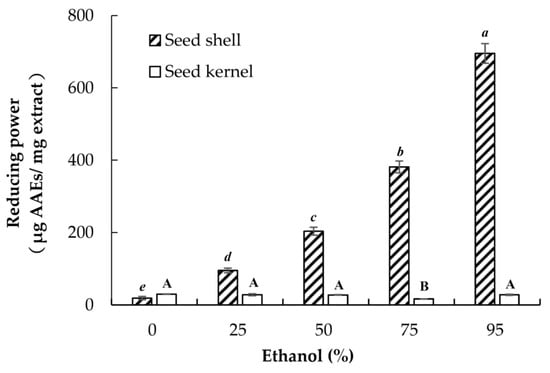
Figure 4.
Reducing power of the seed shell and kernel extracts obtained using ethanol solutions of different concentrations. Mean within the seed shell (in small letter) and within the seed kernel (in capital letter) followed by the same letter(s) are not significantly different at the 5% level by Tukey test.
3.5. Determination of the Total Phenolic Content
The seed shells of J. curcas are thin and hard and have a relatively high phenolic content, which may be related to the function of seed protection [16]. Figure 5 indicates that the total phenolic content of the shell extract increased with the ethanol concentration, which is similar to the result in Figure 4. The phenomenon that an increase of ethanol concentration resulted in a higher extraction of phenolics agree with reports about black currant [35] and Limnophila aromatic [28] The shell extract obtained using 95% ethanol had the highest total phenolic content of 536.33 ± 8.62 μg GAEs/mg of extract. Moreover, a few major differences were observed in the total phenolic content of the kernel extracts.
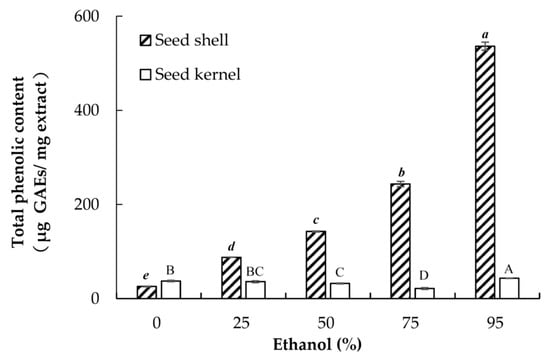
Figure 5.
Total phenolic contents of the seed shell and kernel extracts obtained using ethanol solutions of different concentrations. Mean within the seed shell (in small letter) and within the seed kernel (in capital letter) followed by the same letter(s) are not significantly different at 5% level by Tukey test.
3.6. In Vitro Cytotoxicity Test
The MTT assay can indicate whether a product can be used in biomedical supplies [36]. The J. curcas seed shell extract obtained using 95% ethanol was subjected to an in vitro cytotoxicity test with an MTT assay to calculate the 24-h L929 cell survival percentages in serially diluted extracts and an extract-free sample (Figure 6). The results indicated no major cytotoxicity, with a cell viability of ≥80% [37] when the concentration of DMSO was less than 2.5%, which is in agreement with no morphological alterations or lysis [38]. Therefore, the seed shell extract was dissolved in a 2.5% DMSO solution for the cytotoxicity test in this study.
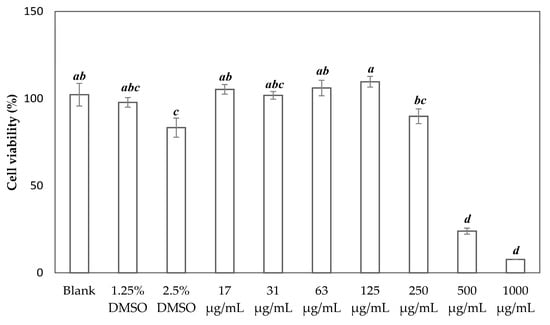
Figure 6.
L929 cell viability after 24-h treatment with shell extracts of different concentrations. Mean followed by the same letter(s) are not significantly different at the 5% level by Tukey test.
The results revealed that no major cytotoxicity was observed when the seed shell extract had a concentration of less than 250 μg/mL. Seed shell extracts with concentrations of less than 250 μg/mL did not alter the viability of fibroblasts. However, at concentrations greater than 500 μg/mL, the extract became potentially toxic and the cell viability decreased.
4. Conclusions
The extraction yield and antioxidant capacity of extracts depend on the plant part from which the extract is derived and the polarity of the extraction solution. In the case of J. curcas seeds, the extract yield of the seed shell was lower than that of the seed kernel. However, the seed shell extract had higher antioxidant capacity, including DPPH and ABTS radical scavenging activities, reducing power, and total phenolic content, than the seed kernel extract. The DPPH and ABTS radical scavenging activities of the seed shell extract obtained using 95% ethanol solution were close to those of ascorbic acid. The in vitro toxicity was conducted to determine the concentration of the seed shell extract that should be used. Further research and development of J. curcas seeds can considerably benefit domains such as health care and cosmetics.
Author Contributions
Conceptualization and supervision, Y.-S.L.; data curation, X.-Y.Z. and C.-T.L.; formal analysis, S.-L.H., W.-H.W., W.-S.L., and M.-Y.C.; writing—original draft preparation, X.-Y.Z. and C.-T.L.; writing—review and editing, Y.-S.L. All authors have read and agreed to the published version of the manuscript.
Funding
This research was funded by National United University (108-NUULSP003) and the Ministry of Science and Technology, Taiwan.
Conflicts of Interest
The authors declare that they have no conflicts of interest. The funding sponsor played no role in the design of the study; the collection, analyses, or interpretation of data; the writing of the manuscript; nor in the decision to publish the results.
References
- Osman, S.A.; Abdullah, N.N.; Ahmad, S. Antioxidant activity and phytochemical components of Jatropha curcas Linn. root extract. J. Biochem. Microbiol. Biotechnol. 2017, 5, 2–7. [Google Scholar]
- Boudjeko, T.; Ngomoyogoli, J.E.K.; Woguia, A.L.; Yanou, N.N. Partial characterization, antioxidative properties and hypolipidemic effects of oilseed cake of Allanblackia floribunda and Jatropha curcas. BMC Complement. Altern. Med. 2013, 13, 352. [Google Scholar] [CrossRef]
- Augustus, G.D.P.S.; Jayabalan, M.; Seiler, G.J. Evaluation and bioinduction of energy components of Jatropha curcas. Biomass Bioenergy 2002, 23, 161–164. [Google Scholar] [CrossRef]
- Openshaw, K. A review of Jatropha curcas: An oil plant of unfulfilled promise. Biomass Bioenergy 2000, 19, 1–15. [Google Scholar] [CrossRef]
- Rampadarath, S.; Puchooa, D.; Ranghoo-Sanmukhiya, V.M. Antimicrobial, phytochemical and larvicidal properties of Jatropha multifida Linn. Asian Pac. J. Trop. Med. 2014, 7, S380–S383. [Google Scholar] [CrossRef]
- Ling, T.; Hadi, V.; Guiguemde, A.; Landfear, S.M.; Rivas, F. Jatropha Natural Products as Potential Therapeutic Leads. In The Formation, Structure and Activity of Phytochemicals; Springer: New York, NY, USA; Cham, Switzerland, 2015; pp. 77–98. [Google Scholar]
- Ohtani, M.; Nakano, Y.; Sano, R.; Kurata, T.; Demura, T. Toxic Substances in Jatropha Seeds: Biosynthesis of the Most Problematic Compounds, Phorbol Esters. In The Jatropha Genome; Springer: Cham, Switzerland, 2017; pp. 97–111. [Google Scholar]
- Oskoueian, E.; Abdullah, N.; Ahmad, S.; Saad, W.Z.; Omar, A.R.; Ho, Y.W. Bioactive compounds and biological activities of Jatropha curcas L. kernel meal extract. Int. J. Mol. Sci. 2011, 12, 5955–5970. [Google Scholar] [CrossRef]
- Sundari, J.; Selvaraj, R.; Prasad, N.R.; Elumalai, R. Jatropha curcas leaf and bark fractions protect against ultraviolet radiation-B induced DNA damage in human peripheral blood lymphocytes. Environ. Toxicol. Pharmacol. 2013, 36, 875–882. [Google Scholar] [CrossRef]
- Namuli, A.; Abdullah, N.; Sieo, C.C.; Zuhainis, S.W.; Oskoueian, E. Phytochemical compounds and antibacterial activity of Jatropha curcas Linn. extracts. J. Med. Plants Res. 2011, 5, 3982–3990. [Google Scholar]
- Insanu, M.; Dimaki, C.; Wilkins, R.; Brooker, J.; Van der Linde, P.; Kayser, O. Rational use of Jatropha curcas L. in food and medicine: From toxicity problems to safe applications. Phytochem. Rev. 2013, 12, 107–119. [Google Scholar] [CrossRef]
- Aiyelaagbe, O.O.; Hamid, A.A.; Fattorusso, E.; Taglialatela-Scafati, O.; Schröder, H.C.; Müller, W.E. Cytotoxic activity of crude extracts as well as of pure components from Jatropha species, plants used extensively in African traditional medicine. Evid. Based Complement. Altern. Med. 2011, 2011, 134954. [Google Scholar] [CrossRef]
- Devappa, R.K.; Makkar, H.P.; Becker, K. Localisation of antinutrients and qualitative identification of toxic components in Jatropha curcas seed. J. Sci. Food Agric. 2012, 92, 1519–1525. [Google Scholar] [CrossRef]
- Verma, S.; Gupta, A.; Kushwaha, P.; Khare, V.; Srivastava, S.; Rawat, A.K.S. Phytochemical evaluation and antioxidant study of Jatropha curcas seeds. Pharmacogn. J. 2012, 4, 50–54. [Google Scholar] [CrossRef]
- Nithiyanantham, S.; Siddhuraju, P.; Francis, G. A promising approach to enhance the total phenolic content and antioxidant activity of raw and processed Jatropha curcas L. kernel meal extracts. Ind. Crops Prod. 2013, 43, 261–269. [Google Scholar] [CrossRef]
- Fu, R.; Zhang, Y.; Guo, Y.; Liu, F.; Chen, F. Determination of phenolic contents and antioxidant activities of extracts of Jatropha curcas L. seed shell, a by-product, a new source of natural antioxidant. Ind. Crops Prod. 2014, 58, 265–270. [Google Scholar] [CrossRef]
- Islam, A.K.M.A.; Yaakob, Z.; Anuar, N. Jatropha: A multipurpose plant with considerable potential for the tropics. Sci. Res. Essays 2011, 6, 2597–2605. [Google Scholar]
- Pinelo, M.; Manzocco, L.; Nunez, M.J.; Nicoli, M.C. Solvent effect on quercetin antioxidant capacity. Food Chem. 2004, 88, 201–207. [Google Scholar] [CrossRef]
- Tsai, C.C.; Chan, C.F.; Huang, W.Y.; Lin, J.S.; Chan, P.; Liu, H.Y.; Lin, Y.S. Applications of Lactobacillus rhamnosus spent culture supernatant in cosmetic antioxidation, whitening and moisture retention applications. Molecules 2013, 18, 14161–14171. [Google Scholar] [CrossRef]
- Huang, W.Y.; Lee, P.C.; Hsu, J.C.; Lin, Y.R.; Chen, H.J.; Lin, Y.S. Effects of water quality on dissolution of yerba mate extract powders. Sci. World J. 2014, 2014, 768742. [Google Scholar] [CrossRef]
- Chan, C.F.; Wu, C.T.; Huang, W.Y.; Lin, W.S.; Wu, H.W.; Huang, T.K.; Chang, M.Y.; Lin, Y.S. Antioxidation and melanogenesis inhibition of various Dendrobium tosaense extracts. Molecules 2018, 23, 1810. [Google Scholar] [CrossRef]
- Wu, C.T.; Agrawa, D.C.; Huang, W.Y.; Hsu, H.C.; Yang, S.J.; Huang, S.L.; Lin, Y.S. Functionality analysis of spent coffee ground extracts obtained by the hydrothermal method. J. Chem. 2019, 2019, 4671438. [Google Scholar] [CrossRef]
- Chang, M.Y.; Lin, Y.Y.; Chang, Y.C.; Huang, W.Y.; Lin, W.S.; Chen, C.Y.; Huang, S.L.; Lin, Y.S. Effects of infusion and storage on antioxidant activity and total phenolic content of black tea. Appl. Sci. 2020, 10, 2685. [Google Scholar] [CrossRef]
- Huang, W.Y.; Lin, Y.R.; Ho, R.F.; Liu, H.Y.; Lin, Y.S. Effects of water solutions on extracting green tea leaves. Sci. World J. 2013, 2013, 368350. [Google Scholar] [CrossRef]
- De la Rosa, L.A.; Alvarez-Parrilla, E.; Shahidi, F. Phenolic compounds and antioxidant activity of kernels and shells of Mexican pecan (Carya illinoinensis). J. Agric. Food Chem. 2010, 59, 152–162. [Google Scholar] [CrossRef]
- Contini, M.; Baccelloni, S.; Massantini, R.; Anelli, G. Extraction of natural antioxidants from hazelnut (Corylus avellana L.) shell and skin wastes by long maceration at room temperature. Food Chem. 2008, 110, 659–669. [Google Scholar] [CrossRef]
- Musa, K.H.; Abdullah, A.; Jusoh, K.; Subramaniam, V. Antioxidant activity of pink-flesh guava (Psidium guajava L.): Effect of extraction techniques and solvents. Food Anal. Methods 2011, 4, 100–107. [Google Scholar] [CrossRef]
- Do, Q.D.; Angkawijaya, A.E.; Tran-Nguyen, P.L.; Huynh, L.H.; Soetaredjo, F.E.; Ismadji, S.; Ju, Y.H. Effect of extraction solvent on total phenol content, total flavonoid content, and antioxidant activity of Limnophila aromatica. J. Food Drug Anal. 2014, 22, 296–302. [Google Scholar] [CrossRef]
- Rofida, S. Antioxidant activity of Jatropha curcas and Jatropha gossypifolia by DPPH method. Farmasains 2015, 2, 281–284. [Google Scholar]
- Haq, M.N.U.; Wazir, S.M.; Ullah, F.; Khan, R.A.; Shah, M.S.; Khatak, A. Phytochemical and biological evaluation of defatted seeds of Jatropha curcas. Sains Malays. 2016, 45, 1435–1442. [Google Scholar]
- Alimpić, A.Z.; Duletić-Laušević, S.N.; Matevski, V.S.; Marin, P.D. Antioxidant activity of Salvia jurisicii Košanin ethanol extracts. Bot. Serbica 2015, 39, 53–58. [Google Scholar]
- Dhanani, T.; Shah, S.; Gajbhiye, N.A.; Kumar, S. Effect of extraction methods on yield, phytochemical constituents and antioxidant activity of Withania somnifera. Arab. J. Chem. 2017, 10, S1193–S1199. [Google Scholar] [CrossRef]
- Kumar, A.; Kumar, P.; Koundal, R.; Agnihotri, V.K. Antioxidant properties and UPLC-MS/MS profiling of phenolics in jacquemont’s hazelnut kernels (Corylus jacquemontii) and its byproducts from western Himalaya. J. Food Sci. Technol. 2016, 53, 3522–3531. [Google Scholar] [CrossRef]
- Ghali, W.; Vaudry, D.; Jouenne, T.; Marzouki, M.N. Assessment of cyto-protective, antiproliferative and antioxidant potential of a medicinal plant Jatropha podagrica. Ind. Crops Prod. 2013, 44, 111–118. [Google Scholar] [CrossRef]
- Nour, V.; Stampar, F.; Veberic, R.; Jakopic, J. Anthocyanins profile, total phenolics and antioxidant activity of black currant ethanolic extracts as influenced by genotype and ethanol concentration. Food Chem. 2013, 141, 961–966. [Google Scholar] [CrossRef]
- Othman, A.R.; Abdullah, N.; Ahmad, S.; Ismail, I.S.; Zakaria, M.P. Elucidation of in-vitro anti-inflammatory bioactive compounds isolated from Jatropha curcas L. plant root. BMC Complement. Altern. Med. 2015, 15, 11. [Google Scholar] [CrossRef]
- Marchesan, S.; Qu, Y.; Waddington, L.J.; Easton, C.D.; Glattauer, V.; Lithgow, T.J.; McLean, K.M.; Forsythe, J.S.; Hartley, P.G. Self-assembly of ciprofloxacin and a tripeptide into an antimicrobial nanostructured hydrogel. Biomaterials 2013, 34, 3678–3687. [Google Scholar] [CrossRef]
- De Oliveira, R.B.; Vaz, A.; Alves, R.O.; Liarte, D.B.; Donnici, C.L.; Romanha, A.J.; Zani, C.L. Arylfurans as potential Trypanosoma cruzi trypanothione reductase inhibitors. Memórias Do Inst. Oswaldo Cruz 2006, 101, 169–173. [Google Scholar] [CrossRef]
© 2020 by the authors. Licensee MDPI, Basel, Switzerland. This article is an open access article distributed under the terms and conditions of the Creative Commons Attribution (CC BY) license (http://creativecommons.org/licenses/by/4.0/).